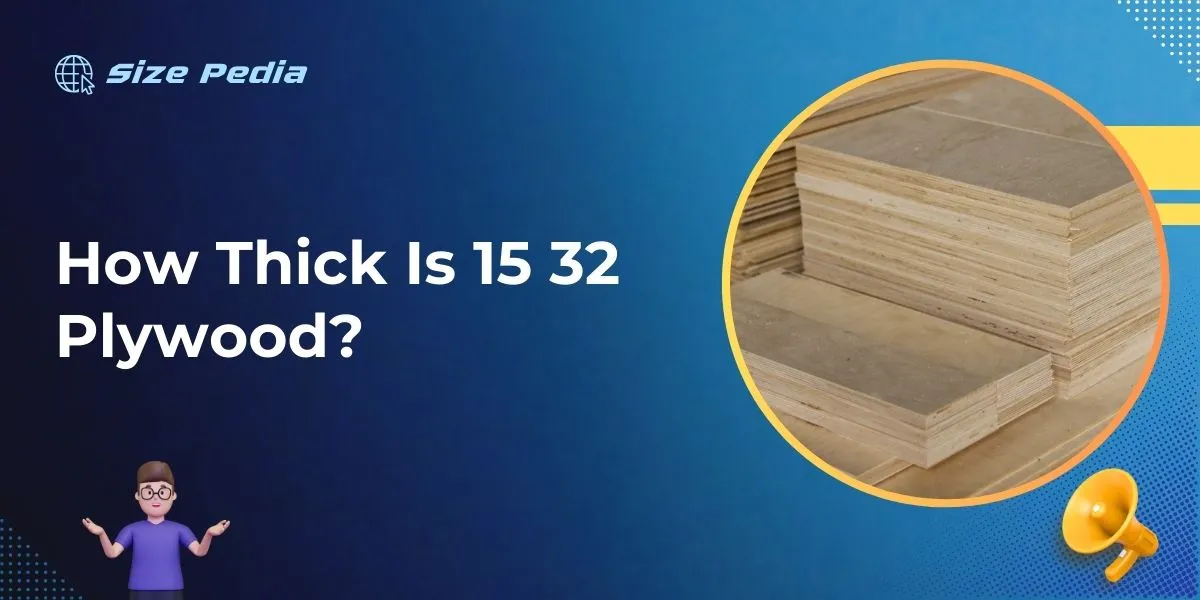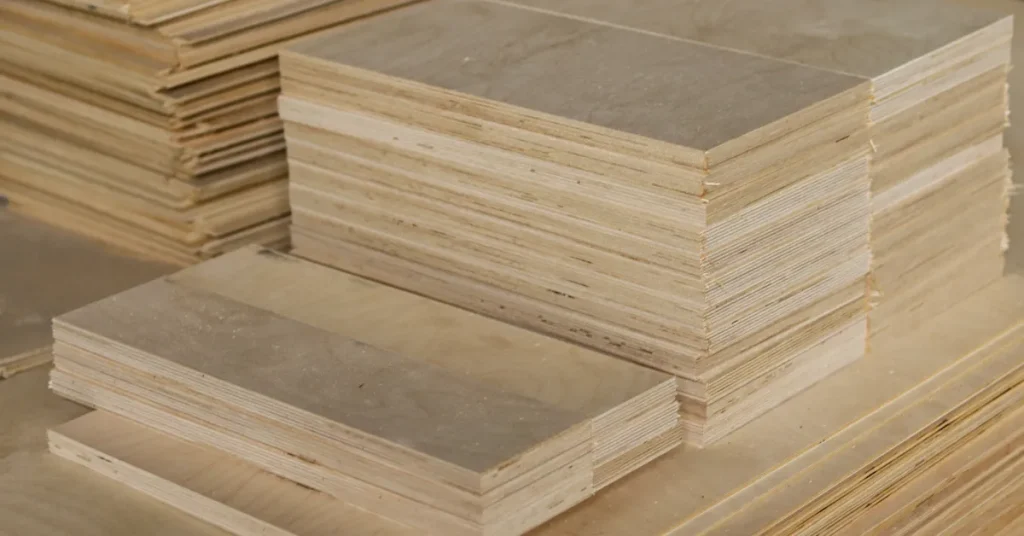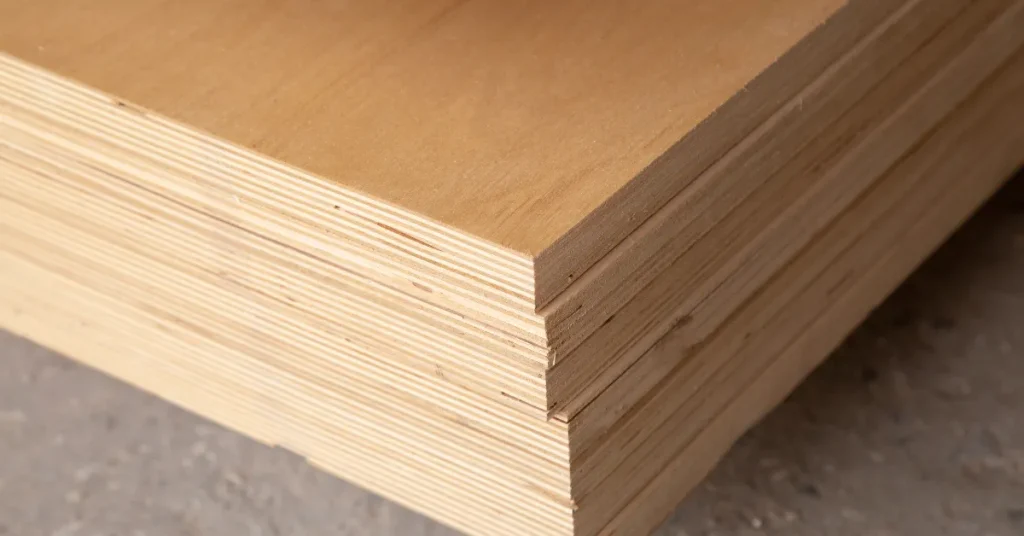15/32-inch plywood is approximately 0.46875 inches thick. This measurement translates to about 11.9 millimeters.
Plywood sheets come in various thicknesses, with 15/32-inch being a common option for construction and DIY projects. This size is ideal for applications that require sturdy, yet not overly thick, panels such as subflooring, wall sheathing, and roofing.
Crafted from multiple layers of wood veneer glued together, this type of plywood offers a balance between strength and weight, making it a versatile choice for both indoor and outdoor use.
Choosing the right plywood thickness is crucial for the stability and longevity of your project, and 15/32-inch plywood offers a sweet spot for many builders who seek reliable performance without the bulk of thicker panels.

Unveiling Plywood Measurements
Understanding plywood measurements is key when tackling any woodworking project. To ensure you pick the right thickness, it’s crucial to know the exact dimensions of plywood sheets available. Let’s dive into the details of one common size – 15/32 inch plywood.
Comparing Common Plywood Thicknesses
Plywood comes in various thicknesses to suit different project needs. Here is a quick comparison:
| Thickness | Use |
| 1/4 inch | Light paneling, crafts |
| 3/8 inch | Lightweight furniture, decorative work |
| 1/2 inch | Cabinets, shelving |
| 5/8 inch | Floors, roofs |
| 3/4 inch | Heavy-duty projects, subfloors |
Decoding Plywood Dimensions: The 15/32 Inch Mystery
The thickness of 15/32 inch plywood can be confusing. It’s just shy of 1/2 inch. Why not just call it 1/2 inch? Plywood is often slightly thinner than its nominal dimension. This is due to the sanding process during manufacturing. Let’s break it down:
- Nominal Thickness: What the plywood is called, like 1/2 inch.
- Actual Thickness: The true measurement after sanding, like 15/32 inch.
A piece of 15/32 inch plywood is strong for building cabinets or shelving. It strikes a balance between durability and ease of handling. Remember, not all plywood marked as 1/2 inch is actually 1/2 inch!
The Significance Of 15/32 Inch Plywood In Construction
Plywood plays a pivotal role in the world of construction. Its size, particularly 15/32 inch thickness, is a prime choice for varied projects. This size strikes a balance between strength and manageability, making it ideal for walls, roofing, and flooring.
Strength And Durability Considerations
The right thickness of plywood ensures that a construction project has the backbone to last. 15/32 inch plywood boasts a robust structure. This thickness supports everyday use without compromising on the ability to withstand weight and stress. Below are key points:
- Resists bending and warping, maintaining shape over time
- Durable against environmental factors like moisture and temperature changes
- Optimal thickness enhances panel integrity against impact and wear
Why Thickness Matters: Load Bearing And Insulation
Plywood serves two main functions: bearing loads and providing insulation. The 15/32 inch variety caters well to these aspects. Here’s why this particular thickness is important:
| Aspect | Benefits of 15/32 Inch Plywood |
| Load Bearing | Supports substantial weightPrevents structural saggingDelivers a stable foundation |
| Insulation | Contributes to thermal resistanceReduces energy costsEnhances acoustic properties |
In summary, 15/32 inch plywood provides the necessary characteristics for dependable and efficient construction. It’s a choice that professionals trust for its multifaceted applications in the building industry.
Calculating The Right Thickness For Your Project

When tackling a woodworking or construction project, selecting the ideal plywood thickness is crucial. Different tasks need varied plywood strength and flexibility.
As you embark on your project, understanding the specifics of a 15/32 inch plywood thickness will guide your choices.
Factoring In Load And Span
Your project’s longevity relies on two key elements: load and span capabilities of the plywood. Here’s what to consider:
- Load capacity: How much weight will the plywood need to support?
- Span length: What is the distance between supports?
Wider spans require thicker plywood to maintain structural integrity. A 15/32 inch plywood can handle moderate loads over shorter spans effectively.
| Span (ft) | Max Load (psf) |
| Under 2 ft | Heavy |
| 2-4 ft | Moderate |
Considering Plywood Grades And Types
Different grades and types of plywood offer unique benefits. Consider these aspects:
- Grade: Determines plywood quality. Higher grades are smoother and more uniform.
- Type: Refers to plywood’s intended use. Exterior types resist water better than interior types.
Ensure to match the plywood grade and type to your project’s requirements. 15/32 inch plywood with a suitable grade can lead to optimal outcomes.
Expert Tips For Working With 15/32 Plywood
Plywood thickness, specifically 15/32 inch, plays a critical role in various woodworking projects.
Working with this plywood demands knowledge and precision for optimal results. This section provides expert advice on handling 15/32 plywood.
Cutting And Installation Best Practices
Accurate measurements and sharp tools are key for cutting plywood. Use a straightedge guide for straight cuts. Support the plywood on a stable surface to prevent bending.
Pre-drill holes to avoid splitting when installing. Apply even pressure with clamps to hold the plywood in place. Sand the edges for a smooth finish after cutting.
- Measure twice, cut once: Ensure dimensions are exact.
- Maintain sharp blades: Dull blades cause splintering.
- Support the sheet: Prevents sagging and accidental breaks.
- Pre-drill holes: Reduces splitting during installation.
- Use clamps: Secures plywood during work.
- Sand edges: Removes splinters and smoothes surface.
Avoiding Common Mistakes With Thin Plywood
Thin plywood, like 15/32 inch, is prone to damage if mishandled. Do not force the saw through the material.
Avoid excessive force when nailing or screwing. Store sheets flat to prevent warping. Seal cut edges to protect against moisture. Use the correct thickness for the project requirements.
- Go slow with the saw: Prevents tearing the veneer.
- Gentle nailing/screwing: Minimizes damage.
- Flat storage: Keeps plywood straight.
- Edge sealing: Protects against moisture.
- Appropriate thickness: Ensures structural integrity.
Alternatives To 15/32 Plywood
Exploring alternatives to 15/32 plywood brings a world of options to the table. Diverse project needs demand a variety of thicknesses and materials.
From lighter sheets for easier handling to denser boards for robust projects, alternatives offer a tailored approach. Understand the substitutes that can fit your specific project requirements.
When To Opt For Thicker Or Thinner Plywood

Choosing between thicker or thinner plywood depends on project needs. Thinner plywood, such as 1/4″ or 3/8”, offers flexibility and lightness, ideal for applications like paneling or furniture backs.
On the flip side, thicknesses beyond 15/32″, like 1/2″ or 3/4”, are excellent for durability and structural projects such as subflooring or cabinetry.
- Thinner Plywood: Lightweight and flexible, perfect for non-structural decor.
- Thicker Plywood: Adds strength and stability for demanding builds.
Innovative Plywood Products And Their Uses
Plywood innovation has led to specialized products serving unique applications. From moisture-resistant types to eco-friendly options, the plywood market is vibrant:
| Plywood Type | Characteristics | Common Uses |
| Marine Plywood | Waterproof glue, resists warping | Boats, docks |
| Bamboo Plywood | Sustainable, high strength | Furniture, wall panels |
| Flexible Plywood | Can bend, light-duty | Curved pieces, formwork |
| Fire-retardant Plywood | Treated for flame resistance | Public buildings, institutions |
Every project has its own set of requirements and knowing the right plywood variant makes a world of difference. Whether for structural integrity or a visual treat, there’s a plywood type tailored just for your needs.
FAQs About How Thick Is 15 32 Plywood
Is 15 32 The Same As Half Inch Plywood?
No, 15/32 inch plywood is not the same as half-inch plywood. It is slightly thinner, with half-inch plywood being closer to 1/32 inch thicker.
What Is The Actual Thickness Of 15 32 Plywood?
15/32-inch plywood has an actual thickness of approximately 0. 46875 inches, just under half an inch.
What Is The Actual Thickness Of 19 32 Plywood?
The actual thickness of 19/32-inch plywood is approximately 0. 594 inches. This measurement can slightly vary due to manufacturing tolerances.
Is 15 32 Plywood The Same As 5 8 Plywood?
No, 15/32 plywood is not the same as 5/8 plywood. The thickness of 15/32 plywood is slightly less than 1/2 inch, while 5/8 plywood is thicker, at 5/8 inch.
Conclusion
Understanding the thickness of 15/32 plywood is crucial for successful construction and DIY projects. At just under half an inch, this versatile material offers a balance between durability and ease of handling.
Whether you’re crafting furniture or sheathing walls, knowing your material’s specifications ensures a flawless finish to any endeavor.
Choose wisely and build with confidence!
Resources:
1. https://www.nist.gov/system/files/documents/2017/06/13/doc_ps_1-09_structural_plywood.pdf
